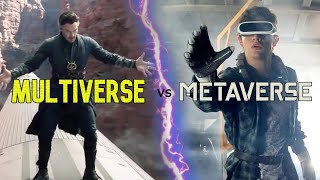
By Amit CaesarAs Meta (formerly Facebook) shifts its focus toward building immersive virtual spaces, the global conversation around digital realities is evolving. Are we heading into a singular connected universe — the metaverse — or are we exploring countless, disconnected virtual realities — the multiverse?The metaverse, a term originally coined in Neal Stephenson’s 1992 novel Snow Crash, is no longer just science fiction. Today, it's a real technological frontier, combining augmented reality (AR), virtual reality (VR), and mixed reality (MR) into immersive, interactive spaces where people live, work, learn, and play.But as each company builds its own virtual ecosystem — from Meta’s Horizon Worlds to Microsoft’s Mesh and independent platforms like Decentraland, Sandbox, and Roblox — a fundamental question arises:
Are we building one metaverse — or many?
🔍 Understanding the Difference: Metaverse vs. Multiverse
✅ The Metaverse is Being Built — The Multiverse is Theoretical
The metaverse is under active development and already accessible in parts. You can log into VR spaces today and interact using your avatar.
In contrast, the multiverse stems from theoretical physics — a concept suggesting parallel universes, each with its own laws of nature, realities, or timelines.
🌐 The Metaverse Aims for Interoperability — The Multiverse Is Naturally Fragmented
The goal of the metaverse is to allow seamless movement across digital worlds using the same identity, assets (like NFTs), and experiences.
In the multiverse, worlds may coexist without any connection or ability to interact. Just as in physics, they may follow entirely different rules.
🎮 The Metaverse Is Immersive and Social — The Multiverse Is Diverse and Speculative
The metaverse prioritizes human-computer interaction — avatars, spatial audio, and haptic feedback — to mimic real-world presence.
The multiverse, on the other hand, may contain 2D or abstract dimensions, ranging from game environments like Minecraft to hypothetical alien realms.
🧠 What Is the Metaverse — and How Does It Work?
The metaverse is a unified, immersive 3D space that merges VR, AR, MR, and AI into one interactive digital universe. It’s not just about gaming — it's about:
- Attending virtual concerts and meetings
- Learning languages in simulated environments
- Shopping in virtual malls
- Exploring new forms of identity and creativity
From Second Life to Meta Quest 3, we've seen the evolution from pixel-based simulations to full-bodied digital presence with lifelike motion tracking, spatial computing, and eye contact.
🌌 What Is the Multiverse, Really?
In science, the multiverse refers to a set of infinite or finite universes — each with different laws, constants, or histories.
Some may resemble our own with small variations. Others may be governed by entirely alien rules.In digital terms, the multiverse represents independent virtual worlds with no interoperability. Each game, app, or digital ecosystem may be its own "universe."
⚔️ Who Will Win: Metaverse or Multiverse?
The truth is: they can coexist.
- The metaverse is a technological goal — to unify and connect.
- The multiverse is a philosophical and scientific theory — to explore what else could exist.
Facebook (Meta) predicts over 1 billion users will be in the metaverse by 2031. Meanwhile, the multiverse may one day include a parallel world where the metaverse never existed — or one where it already has.
“The future of digital existence may not be about choosing between the metaverse and the multiverse — but learning to live in both.”


